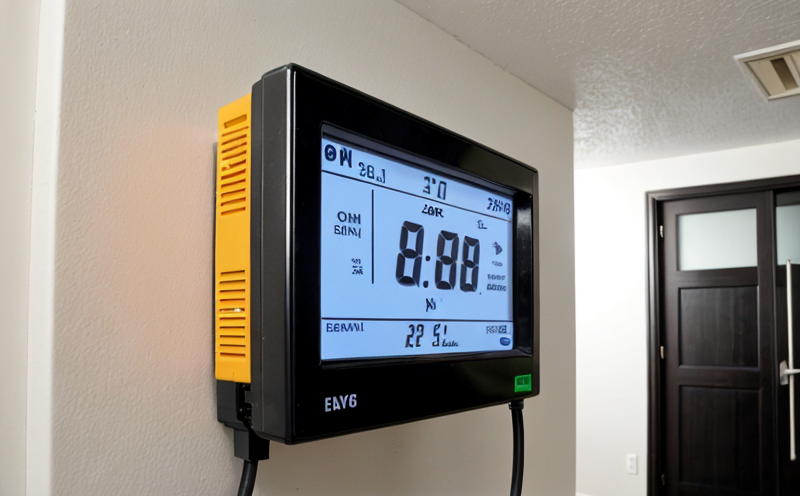EN 15193 Building Energy Efficiency Testing for Lighting Systems
The European standard EN 15193 is a cornerstone in the field of building energy efficiency, specifically targeting lighting systems. This normative document provides detailed specifications for testing and evaluating the energy performance of lighting installations within buildings. The primary goal of this test is to ensure that lighting systems contribute effectively to reducing overall energy consumption while maintaining high levels of comfort and functionality.
The standard applies to a wide range of indoor lighting applications, including but not limited to offices, schools, hospitals, and retail spaces. It focuses on the measurement of various parameters such as light output, power consumed, efficacy (lumen per watt), and color rendering index. These metrics are crucial in determining how efficiently a lighting system operates within its intended space.
Testing under EN 15193 involves several key steps that must be meticulously followed to ensure accuracy and reliability of the results:
- Preparation of Specimens: The lighting fixtures or systems being tested need to be installed in a controlled environment that simulates real-world conditions as closely as possible. This includes factors like ambient temperature, humidity levels, and surrounding finishes.
- Data Collection: During testing, multiple data points are recorded over time to account for variations due to environmental changes or operational modes. Instruments calibrated according to international standards (e.g., ISO 17025) are used to measure these parameters accurately.
- Analysis and Reporting: After collecting sufficient data, it is analyzed using established formulas provided in the standard. The final report presents findings regarding compliance with specified criteria along with recommendations for improvement if necessary.
The importance of adhering strictly to EN 15193 cannot be overstated, especially considering its role in promoting sustainable development goals set forth by international organizations like ISO and UN Environment Programme (UNEP). By implementing this standard, stakeholders can make informed decisions about selecting energy-efficient lighting solutions that not only save money but also reduce greenhouse gas emissions.
In conclusion, EN 15193 serves as an essential tool for ensuring that modern buildings incorporate advanced technologies capable of enhancing both environmental sustainability and occupant well-being. Its rigorous testing procedures help guarantee that all components meet stringent quality standards, contributing significantly towards achieving broader objectives related to climate change mitigation efforts.
Benefits
- Enhanced Efficiency: Compliance with EN 15193 ensures that lighting systems operate at peak efficiency, leading to reduced energy bills and lower carbon footprints.
- Sustainable Development: By adhering to this standard, organizations demonstrate their commitment to responsible resource management and sustainable practices.
- Regulatory Compliance: The test results obtained from EN 15193 can be used to meet regulatory requirements imposed by government agencies worldwide.
- Innovation Promotion: This standard encourages continuous improvement in lighting technology, fostering innovation within the industry.
Why Choose This Test
Selecting EN 15193 for your building energy efficiency testing needs is a wise decision due to its comprehensive approach and wide applicability. Here are some compelling reasons why you should consider this standard:
- Global Recognition: As an internationally recognized standard, compliance with EN 15193 enhances credibility and trust among clients, partners, and stakeholders.
- Cost Savings: By identifying inefficiencies early in the design process, you can avoid costly retrofits later on.
- Long-Term Value: Investing time and resources into thorough testing ensures long-term cost savings through optimized energy usage.
- Expertise Assurance: Partnering with a reputable laboratory that specializes in EN 15193 guarantees accurate, reliable results backed by experienced professionals.
In summary, choosing EN 15193 for your lighting system testing not only streamlines regulatory compliance but also paves the way for adopting best practices aligned with global trends toward sustainability and efficiency.
Environmental and Sustainability Contributions
The implementation of EN 15193 goes beyond mere testing; it plays a pivotal role in fostering environmental stewardship and promoting sustainable practices across various sectors. Through rigorous evaluation of lighting systems' energy performance, this standard helps mitigate the adverse impacts associated with high electricity consumption.
One significant contribution lies in reducing waste generation by encouraging manufacturers to design products that last longer and perform better over extended periods. Additionally, compliance with EN 15193 encourages innovation around recyclable materials and improved manufacturing processes aimed at minimizing environmental impact throughout a product's lifecycle.
- Energy Savings: By optimizing lighting systems' performance, substantial reductions in electricity usage can be achieved, thereby decreasing reliance on non-renewable resources.
- Emissions Reduction: Lower energy consumption translates directly into fewer pollutants released into the atmosphere, contributing positively to air quality improvement.
- Biodiversity Protection: Sustainable lighting solutions help preserve natural habitats by minimizing disruption caused by artificial light pollution.
To further emphasize its significance in advancing sustainable development goals, let us look at how some leading companies have already integrated EN 15193 into their operations. For instance, major real estate developers now prioritize selecting fixtures certified against this standard when renovating office spaces or constructing new buildings.
Moreover, government initiatives worldwide are increasingly mandating the use of standards like EN 15193 as part of broader strategies aimed at combating climate change and promoting green building practices. These measures reflect a growing recognition that responsible energy management is crucial for future generations' well-being.





